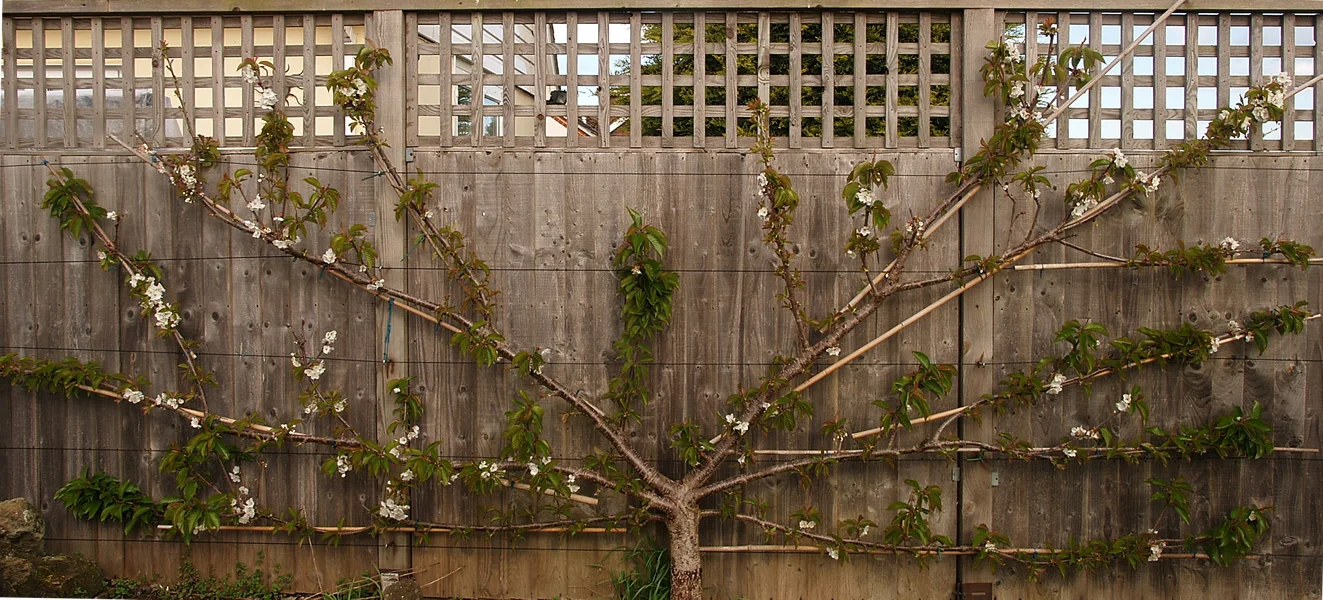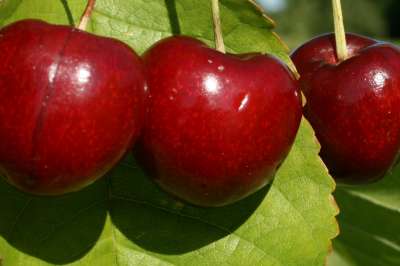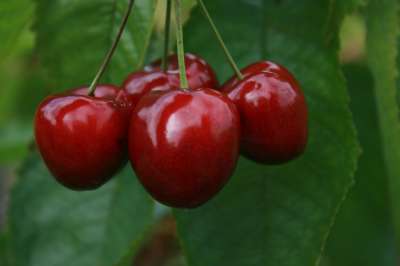Your basket is currently empty!
Online cherry tree catalogue viewable here.
The cherry tree must be one of the finest of spring flowering trees yet it is the sumptuous fruits that have gardeners so keen to have cherry trees in their own gardens.
Of the four main fruit tree types [apple, pear, plum & cherry] the cherry is undoubtedly the most demanding yet it is also quite versatile in it’s growth which means that with a little thought and imagination it is possible for all of us to enjoy the delights on offer here, no matter what your locality or gardening circumstance might be. The way in which you grow your cherry tree[s] will be influenced by the conditions you are able to offer.
The cherry is an April flowering tree and a common site in our gardens and driveways at this time; however a lot of these trees are grown just for their blossom and are often confused as ‘the same thing’ by the layman. You first have to make sure you are buying fruiting cherries and not a variety that is purely enjoyed for it’s blossom. Fruiting cherries still have nice blossom but it is single and white, smaller and less exuberant than the many Japanese flowering cherries that have been bred purely for ornamentation.
The cherry tree expects the most favourable of aspects – warmth, sunshine and some shelter. It is suitable for most parts of the country but in the North or exposed positions do not expect it to thrive as a large stand-alone tree. In orchards afford it the most protection you can, in the centre of the plantation or at least so the row faces due south or west. In gardens have a good think about where the best situation is that you can offer it, then peruse the different growing methods that are available. It could be said there is a cherry tree for all situations & gardens including a good many restrictive growing methods, so don’t despair if at first your garden or locality seems unpromising. The smaller the tree the easier it is to find a sheltered spot or to give it the protection it deserves.

Commercially, in England and across much of Europe, cherries are now cultivated under cover. That’s not to say that the trees won’t thrive outside in the open, of course they will as they have done for centuries. But it is a good indicator that professional growers go to so much expense and trouble over this particular crop. Not only does it give more reliable results but it is more possible to influence and control the environment in which they are grown and also indicates that the trees are less able to give of their best when weather conditions decide to behave unpredictably. As home gardeners we need to take these considerations into account before siting our trees and it allows us to prepare more readily for the vagaries of the English weather.
The Many Ways to Grow Cherry Trees
The bush tree is the most familiar and often grown method. These free standing trees are suitable for the orchard, paddock, lawn or larger grassy area. On a Colt rootstock they can be expected to mature to between 8 and 12’ depending on how rigorously they have been pruned. Normally they will have a nice trunk clearance of 3.5’ or more which means they can easily be mown beneath. This is the heaviest cropping growing method and probably the easiest to maintain but these are the trees that will benefit most from a favourable aspect as they will receive less protection than other growing forms and they are also more difficult trees to net against the birds when fruiting time begins.
The dwarf or miniature bush tree
The dwarf or miniature bush tree will normally have been grown on the new Gisela 5 rootstock. This naturally controls the vigour of the tree which means that with normal pruning your tree will reach no more than 6-8’ in height. This makes it ideal for a large container or half barrel as well as the mixed border, fruit cage, smaller orchard and lawn. Easy to net against birds, still heavy cropping and easy to manage.
A columnar cherry tree
A columnar cherry tree is an elegant straight-up-and-down tree with a pillar like shape that takes up very little room. It could be situated in a sheltered corner, along a drive, near a door or entranceway even as well as a container on the secluded patio. This growing form is the easiest of all to prune and maintain as the method is very simple & easy to understand, and it is also the most accommodating. These trees can be planted just 2.5’ apart so if you wanted a row of them you could incorporate several trees in a small space. The columnar cherry tree is also grown on the dwarf Gisela 5 rootstock but it will have been grown and trained differently by the nursery so it has this simple columnar shape.
The fan trained tree
The fan trained tree. If you have a warm south or west facing fence or wall then the fan trained tree is the most ideal way of cultivating cherries in this country. The climate is just perfect for them to fruit well and predictably, and the fruits will be sheltered from heavy rain. Training a fan isn’t the simplest thing in the world to do but specialist nurseries can explain to you what to do & guides are available too. It takes 3-4 years to train up a good fan and the tree will then be ready to start fruiting. You will need a space not less than 6-8’ in height, and the same in spread, for a fan trained tree. Trees grown in this way are easy to net against the birds and the fruits tend to ripen a little earlier than those on trees grown in the open. Sweet cherries grown as fans will not thrive on east or north facing aspects.

The festooned tree
The festooned tree is a tree on Colt rootstock that has had it’s central leader and main side laterals tied down to a post and supporting wire inserted in the ground. This controls the height of the tree naturally and encourages early and heavy cropping, as well as creating a rather nice semi-weeping shape to the tree. It isn’t a method that is often used these days but it’s well worth considering, it isn’t as difficult as it sounds. You need to start with a young tree and at this point the leader and branches are quite flexible and easy to gently pull down. Training should start after the first summers full growth, when you will have lots of soft, flexible growth to work with. Start with the leader itself, gently pulling it down and tieing it with soft twine, either to the main trunk itself near the base, or to a peg in the ground.
During the second summer long side laterals will have formed off of the leader and from the main stem; tie these down again, using the same principle. If you have too many laterals don’t be afraid to remove some otherwise the tree will be too congested. 5 or 6 is a good number when you have completed training in another year or so. From year 3 you can normally remove the twine completely and the branches will stay in place. The only pruning from then on is to shorten the side spurs that appear from the framework of branches that you have – these will carry the fruiting buds. Any other major growths that appear can either be removed or tied in if you have gaps that you want to fill. If a new upward leader should appear then this should be pruned out in late Summer. This method actually encourages the early production of fruiting buds.






